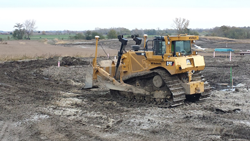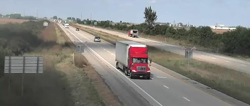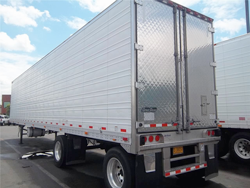Project Details
07/01/15
07/31/18
Iowa State University
Midwest Transportation Center
USDOT/OST-R
Researchers
Senem Velipasalar
Akhan Almagambetov
Yaw Adu-Gyamfi
About the research
A key to the development of effective crash countermeasures is an understanding of pre-crash causal and contributing factors. Accurately determining the cause or behaviors leading to traffic crashes is a very challenging process. Traditionally, traffic conflict observations by manual or automated means have been used to determine pre-crash causal factors. In recent years, naturalistic driving studies have been used to provide detailed and more accurate pre-crash causal information.
Naturalistic driving databases contain large datasets of low-resolution video streams (due to compression) of highly variable intersections, multiple flows, and turning movements of vehicles under very complex lighting conditions (e.g., constantly varying shadows). This makes automated traffic conflict detection and analysis very challenging. Also, existing vision-based traffic conflict detection systems are not designed to work in naturalistic real world settings; as a result, they fail to extract relevant information from these databases.
To maximize the use of this valuable safety dataset, vision systems with a high-level of understanding of scene dynamics around the naturalistic driver must be developed. The project aims at developing a vision system for understanding pre-crash causal factors through the detection and analysis of traffic conflicts in a naturalistic real world setting.
Funding Sources:
Iowa State University ($22,983.00)
Midwest Transportation Center
USDOT/OST-R ($24,750.00)
Total: $47,733.00
Contract Number: DTRT13-G-UTC37
Researchers
About the research
Utilizing enhanced visualization in transportation planning and design gained popularity in the last decade. The proof-of-concept work aimed at demonstrating the concept of utilizing a highly immersive, virtual reality simulation engine for creating dynamic, interactive, full-scale, three-dimensional (3D) models of highway infrastructure.
For that project, the highway infrastructure element chosen was a two-way, stop-controlled intersection (TWSCI).
VirtuTrace, a virtual reality simulation engine developed by the principal investigator, was used to construct the dynamic 3D model of the TWSCI. The model was implemented in C6, which is Iowa State University’s Cave Automatic Virtual Environment (CAVE).
This continuation of the project is threefold:
(1) Utilize crash data to Identify three types of intersections with high crash rates
(2) Investigate as follows:
- Develop 3D models for the intersections identified.
- Use VirtuTrace, the virtual reality simulation engine developed by the principal investigator (PI), to present full-scale, interactive simulations for the intersections, where designers can change various characteristics of the intersections and road conditions in real time. The simulation will include interactive traffic elements, too, such as various types of vehicles, traveling paths, and speeds).
- Identify a group of experts and use a focus-group approach to examine the intersections for safety deficiencies. The group will examine intersections in two visualization modes (computer monitor vs. C6 (ISU’s CAVE)) and will be asked to identify safety deficiencies and use the real-time component of the simulator to correct the deficiencies (e.g., remove a house located upstream of a two-way stop-controlled intersection or lengthen a merge lane). The simulator will allow examining the scene from a bird’s-eye view, providing a high-level perspective on the intersection and the flow of traffic.
- Data collected during the previous phase will be compared between the two modes of visualizations. The group of experts will be gathered then as a single group. They will be provided with a summary of the data and will discuss the strengths and weaknesses of the different visualization modes and provide recommendations for future efforts and directions.
(3) The PI will work with the instructor of the Highway Design course in the Iowa State University Department of Construction Engineering on developing educational modules that utilize the developments.
Funding Sources:
Iowa State University ($90,831.00)
Midwest Transportation Center
USDOT/OST-R ($111,870.00)
Total: $202,701.00
Contract Number: DTRT13-G-UTC37
Researchers
Alice Alipour
alipour@iastate.edu email >Structure and Infrastructure Engineer, BEC
About the research
Among various infrastructure systems, transportation networks are known as one of the most critical infrastructure systems as they directly contribute to essential societal functions, quality of living, and the economy. It is, thus, extremely important to assess the components of transportation networks holistically and plan for the consequences of possible failure or disruption in their normal service. Furthermore, appropriate arrangements must be made for prompt response and emergency recovery after extreme events to maintain the resilience of the community.
To achieve this goal, this project focuses on highway transportation networks subject to extreme flood events and introduces a comprehensive analytical framework to investigate the resilience measures that contribute to the efficient management of such networks. For this purpose, a multi-scale data-driven approach will be developed to address the critical issue of vulnerability of civil infrastructure systems at both component and system levels.
Based on the flood risk data collected from different parts of the network, the functionality measures are evaluated at regular time intervals to estimate the expected socio-economic losses due to operational closures and extreme events.
One of the unique aspects of this approach is to go above and beyond the physical boundaries of the network and examine the direct and indirect impacts of network disruptions on the entire society. Towards this goal, appropriate resilience measures are introduced in terms of robustness, redundancy, rapidity, and resourcefulness.
The outcome of this study can be immediately used by decision-making authorities, state departments of transportation (DOTs), and nongovernmental organizations (NGOs) to identify the most efficient management strategies for mitigation actions prior to and restoration efforts following the occurrence of flooding events.
Funding Sources:
Iowa State University ($85,482.00)
Midwest Transportation Center
USDOT/OST-R ($79,447.00)
Total: $164,929.00
Contract Number: DTRT13-G-UTC37
Project Details
08/01/15
10/31/16
Iowa State University
Midwest Transportation Center
USDOT/OST-R
Researchers
Fatih Bektaş
About the research
In cold climates, the use of non-durable aggregate leads to premature pavement deterioration due to damage caused by freezing-thawing cycles. Differentiating durable and non-durable aggregates is a crucial yet challenging task. The frost durability of coarse aggregate has been reported to be related to its pore structure; however, existing test methods to identify pore structure are often not cost-effective. There is a need for a quick, reliable, and cost-effective aggregate test whose results correlate well with aggregate freezing-thawing performance.
The Iowa pore index test has been used by the Iowa Department of Transportation (DOT) for three decades as a supplemental decision making tool. This study investigated the relationship between the Iowa pore index and the freezing-thawing performance of aggregates as measured by three other test methods: Canadian Standards Association (CSA) A23.2-24A, Test Method for the Resistance of Unconfined Coarse Aggregate to Freezing and Thawing; ASTM C88, Standard Test Method for Soundness of Aggregates by Use of Sodium Sulfate or Magnesium Sulfate; and an unconfined freezing-thawing test using conditioning according to ASTM C666, Standard Test Method for Resistance of Concrete to Rapid Freezing and Thawing.
The following results were observed:
- The aggregates with a non-carbonate origin outperformed the carbonate aggregates in all three tests.
- The Iowa pore index was found to correlate fairly well to the aggregate performance measured by the unconfined freezing-thawing test using ASTM C666 conditioning and the CSA A23.2-24A test. The correlation of the Iowa pore index to the ASTM C88 test was poor.
- The aggregates with high volumes of micropores performed poorly compared to the aggregates with low volumes of micropores. The correlation between the volume of micropores in an aggregate and the freezing-thawing performance was fairly strong.
Funding Sources:
Iowa State University ($49,990.00)
Midwest Transportation Center
USDOT/OST-R ($49,998.00)
Total: $99,988.00
Contract Number: DTRT13-G-UTC37
Researchers
David White
About the research
Constructing long-lasting roadway infrastructure requires careful process control. It is well known in industry that an in situ manufacturing process governed solely by human operators introduces inefficiencies, variable quality results, and site safety risks. Autonomous and robotic controls of the road building process have great potential to reduce these problems. Unfortunately, roadway construction has virtually no theory established for process control. What is called for is an academic-industry partnership to study and analyze the impacts of productivity, quality, and safety for roadway construction that can quantify and prioritize the formulation of a process control theory to address this need.This project funds three important efforts:
- A nationwide stakeholder conference to identify gaps and opportunities for autonomous and robotics roadway construction technologies
- Selected field studies focused on earthwork and excavation technologies
- A technology transfer program to improve understanding and beneficial implementation
The results of this study are directly related to the State of Good Repair, a key program under MAP-21, and the Midwest Transportation Center (MTC) focus area of project construction, because autonomous and robotic systems impact productivity, quality, and safety of roadway infrastructure.
Funding Sources:
Caterpillar ($60,000.00)
Iowa State University ($15,000.00)
USDOT/OST-R ($75,000.00)
Total: $150,000.00
Contract Number: DTRT13-G-UTC37
Researchers
Yelda Turkan
About the research
Objective, accurate, and fast assessment of a bridge’s structural condition is critical to the timely assessment of safety risks. Current practices for bridge condition assessment rely on visual observations and manual interpretation of reports and sketches prepared by inspectors in the field. Visual observation, manual reporting, and interpretation have several drawbacks, such as being labor intensive, subject to personal judgment and experience, and prone to error. Terrestrial laser scanners (TLS) are promising sensors for automatically identifying structural condition indicators, such as cracks, displacements, and deflected shapes, because they are able to provide high coverage and accuracy at long ranges. However, limited research has been conducted on employing laser scanners to detect cracks for bridge condition assessment, and the research has mainly focused on manual detection and measurement of cracks, displacements, or shape deflections from the laser scan point clouds.
This research project proposed to measure the performance of TLS for the automatic detection of cracks for bridge structural condition assessment. Laser scanning is an advanced imaging technology that is used to rapidly measure the three-dimensional (3D) coordinates of densely scanned points within a scene. The data gathered by a laser scanner are provided in the form of point clouds, with color and intensity data often associated with each point within the cloud. Point cloud data can be analyzed using computer vision algorithms to detect cracks for the condition assessment of reinforced concrete structures. In this research project, adaptive wavelet neural network (WNN) algorithms for detecting cracks from laser scan point clouds were developed based on the state-of-the-art condition assessment codes and standards. Using the proposed method for crack detection would enable automatic and remote assessment of a bridge’s condition. This would, in turn, result in reducing the costs associated with infrastructure management and improving the overall quality of our infrastructure by enhancing maintenance operations.
Funding Sources:
Iowa State University ($65,678.00)
Midwest Transportation Center
USDOT/OST-R ($64,115.00)
Total: $129,793.00
Contract Number: DTRT13-G-UTC37
Researchers
Gilson Lomboy
About the research
A high-performance mortar (HPM) containing a large amount of industrial by-products such as fly ash, silica fume, and limestone fines was developed for rapid repair of concrete pavements. The HPM development included three major steps.
- Development of the mortar mixture proportion based on the optimal hydration of binder and particle packing of the mortar system. In this step of the study, all mortar materials were systematically proportioned, and the obtained mixtures were tested for flowability, rate of hydration, set time, and strength development. The optimal mixture proportion was then selected as the HPM, as it displayed good self-consolidating ability and achieved 1-day compressive strengths greater than 6,000 psi.
- Investigation of the mechanical properties of the new HPM, including compressive and flexural strength, elastic modulus, and slant shear and pull-off strengths of patch-substrate bonds tested at 1, 3, 7, and 28 days. In this step, the properties of the HPM were evaluated in comparison with those of a commercial repair material: the rapid-set concrete (RSC). Two types of substrates representing old concrete were used for patching repair. One was made of a typical pavement mixture (C-3WR-C20), and the other was a high-strength pavement concrete mixture (O-4WR).
- Investigation of the durability properties of the newly developed HPM compared to those of the RSC. Durability properties included cyclic freeze-thaw (F-T) resistance, permeability, and shrinkage behavior.
The results indicated that the newly developed HPM possesses excellent self-consolidating ability: highly flowable and non-segregating. Although there was delayed setting, the compressive strength of the HPM exceeded 6,000 psi at 1 day, approximately 25 percent higher than that of the RSC. At 28 days, the HPM reached 10,000 psi, while the RSC was about 7,000 psi. The HPM also displayed extremely low chloride permeability (18 coulombs) compared to the RSC (2,550 coulombs) and excellent F-T durability without the requirement for air entrainment. The F-T durability factor of HPM was kept around 100% throughout the standard F-T test, while the F-T durability factor of RSC reduced to 80% at the end of the F-T test. However, the HPM exhibited noticeably higher autogenous shrinkage and slightly lower free drying shrinkage than the C-3WR-C20 mixture, while the RSC had a little/no shrinkage during the 56-day test period. Addition of a small amount of micro-steel fibers (70 pcy) slightly reduced the shrinkage of the HPM.
Further studies on fatigue and shrinkage cracking behavior of the HPM are recommended.concrete
Funding Sources:
Iowa State University ($75,000.00)
Midwest Transportation Center
USDOT/OST-R ($75,000.00)
Total: $150,000.00
Contract Number: DTRT13-G-UTC37
Project Details
08/01/14
03/31/16
Iowa State University
Midwest Transportation Center
USDOT/OST-R
Researchers
Say Kee Ong
About the research
The objective of this research was to investigate the physical/chemical and water flow characteristics of various previous concrete mixes made of different concrete materials and their effectiveness in attenuating water pollution. Four pervious concrete mixes were prepared with Portland cement and with 15% cementitious materials (slag, limestone powder, and fly ash) as a Portland cement replacement.
All four pervious concrete mixtures had acceptable workability. The unit weight of the fresh pervious concrete mixtures ranged from 115.9 lb/yd3 to 119.6 lb/yd3, while the 28 day compressive strength of the pervious concrete mixes ranged from 1858 psi (mix with 15% slag) to 2285 psi (pure cement mix). The compressive strength generally increased with unit weight and decreased with total porosity (air void ratio). The permeability of the four mixes generally decreased with unit weight and increased with total porosity. The permeability coefficients ranged from 340 in./hr for the pure cement mix to 642 in./hr for the mix with 15% slag. The total porosities of the four pervious concrete mixes ranged from 24.00% (mix with 15% slag) to 31.41% (pure cement mix) as measured by the flatbed scanner test method, while the porosities ranged from 18.93% (mix with 15% slag) to 24.15% (pure cement mix) as measured by the RapidAir method. The total porosities of the four pervious concrete mixes measured by the flatbed scanner method were higher than those measured by the Rapid Air method, but the specific surface areas measured by the flatbed scanner method were all lower than those measured by the Rapid Air method. For the pollution abatement experiments, mixes with fly ash and limestone powder removed about 30% of the input naphthalene concentration, while the mix with slag only removed 0.5% of the influent naphthalene concentration. The water volume balance showed that less than 1% of the water added was retained in the experimental column setup.
Funding Sources:
Iowa State University ($76,798.00)
Midwest Transportation Center
USDOT/OST-R ($75,000.00)
Total: $151,798.00
Contract Number: DTRT13-G-UTC37
Researchers
Kasthurirangan Gopalakrishnan
Koray Celik
Arun Somani
About the research
State highway agencies (SHAs) routinely employ semi-automated and automated image-based methods for network-level pavement-cracking data collection, and there are different types of pavement-cracking data collected by SHAs for reporting and management purposes.
The main objective of this proof-of-concept research was to develop a shape-based pavement-crack-detection approach for the reliable detection and classification of cracks from acquired two-dimensional (2D) concrete and asphalt pavement surface images.
The developed pavement-crack-detection algorithm consists of four stages: local filtering, maximum component extraction, polynomial fitting of possible crack pixels, and shape metric computation and filtering. After completing the crack-detection process, the width of each crack segment is computed to classify the cracks.
In order to verify the developed crack-detection approach, a series of experiments was conducted on real pavement images without and with cracks at different severities. The developed shape-based pavement crack detection algorithm was able to detect cracks at different severities from both asphalt and concrete pavement images. Further, the developed algorithm was able to compute crack widths from the images for crack classification and reporting purposes.
Additional research is needed to improve the robustness and accuracy of the developed approach in the presence of anomalies and other surface irregularities.
Funding Sources:
Iowa State University ($23,008.00)
Midwest Transportation Center
USDOT/OST-R ($24,986.00)
Total: $47,994.00
Contract Number: DTRT13-G-UTC37
Researchers
David Cantor
About the research
The safety performance of motor carriers is a serious concern in the trucking industry and is a top priority for the U.S. Department of Transportation. This study explored the extent to which a carrier’s use of owner-operators and/or company drivers affects safety performance.
Two primary research questions were addressed: how does motor carrier firm size relate to organizational flexibility, or the use of owner-operators versus company drivers, and does organizational flexibility affect safety performance? The study also examined whether safety performance varies by industry segment.
A dataset based on data obtained for a previous study was created that includes equipment ownership profile information for approximately 108,780 motor carriers. An analysis of the data indicated that the larger the firm, the lower the use of company drivers; contrary to expectations, the use of company drivers results in poorer safety performance; and safety performance varies by industry segment.
Funding Sources:
Iowa State University ($32,763.00)
Midwest Transportation Center
USDOT/OST-R ($25,737.00)
Total: $58,500.00
Contract Number: DTRT13-G-UTC37




